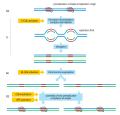File:Overview of chromosome duplication in the cell cycle.svg

Size of this PNG preview of this SVG file: 512 × 488 pixels. Other resolutions: 252 × 240 pixels | 504 × 480 pixels | 806 × 768 pixels | 1,074 × 1,024 pixels | 2,149 × 2,048 pixels.
Original file (SVG file, nominally 512 × 488 pixels, file size: 166 KB)
File history
Click on a date/time to view the file as it appeared at that time.
| Date/Time | Thumbnail | Dimensions | User | Comment | |
|---|---|---|---|---|---|
| current | 00:49, 24 April 2020 |  | 512 × 488 (166 KB) | Rob Hurt | Uploaded a work by David O Morgan from The Cell Cycle. Principles of Control. with UploadWizard |
File usage
The following pages on the English Wikipedia use this file (pages on other projects are not listed):
Global file usage
The following other wikis use this file:
- Usage on ar.wikipedia.org
- Usage on fa.wikipedia.org
- Usage on gl.wikipedia.org
- Usage on ja.wikipedia.org
- Usage on mk.wikipedia.org

